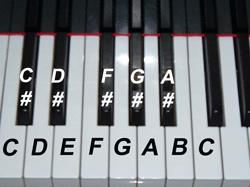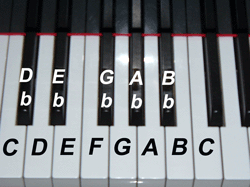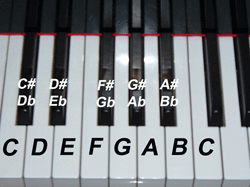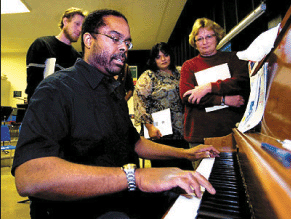by Charley Wyser
Once you have learned the notes on the piano, it is very important to learn about half steps and whole steps. As a refresher, the piano consists of black keys and white keys. When using the black keys as a reference, you will notice that the black keys are divided into sets of two black keys grouped together, and three black keys grouped together. By the sets of two black keys are the notes C, F, and G, and the notes by the three black keys are F, G, A and B.
If you would like more detail on the note names, please access my podcast: Piano Lessons: Learning Notes and Basic Chords in Key of C
Our next step is to now become very familiar with half steps.
These are easy to remember. A half step is the distance from one key to another with no keys in between. For example if you play C, and play the very first key higher (the black key to the right), this is a half step up. As you see, there are no keys in between these two notes.
If you play C again, then play the first note to the left (the white key – B), this is a half step since again, there are no keys in between.
Learning Sharps
Lets focus on going up the keyboard (to the right). We are going to learn the sharps on the piano. First, start on C. Half step up from C would be C sharp, half step up from C sharp is D. The symbol that is used for a sharp in music is the # . Hence, C sharp = C#.
The keys, including all of the sharp keys starting on C and going up are:C, C#, D, D#, E, F, F#, G, G#, A, A#, B, and C (first C higher than middle C)

So you can see that your black keys are C#, D#, F#, G#, and A#. There are also white keys that are sharp – B# (same as C) and E# (same as F). These white sharps are very seldom referred to by this name. They would only go by this name depending on what key that you are playing your tune in.
The important point to remember is that sharps are to the right of the note.
Learning Flats
Flats are easy because they are the opposite of sharps. All you need to remember is that flats go down (to the left) instead of up.
Lets start on the C that is the first one higher than the middle C, and go down in half steps. The notes are:C, B, Bb, A, Ab, G, Gb, F, E, Eb, D, Db, and C (middle C).
The symbol that is used for a flat is a “b”. Hence, going down, your notes are C, B, B flat, A, A flat, G, G flat, F, E, E flat, D, D flat, and C. C).

The flat keys that are black are: Db, Eb, Gb, Ab, and Bb. Again, as with the sharp keys, there are also white keys that are flat – Cb (same as B) and Fb (same as E). These white flats are very seldom referred to by this name. They would only go by this name depending on what key that you are playing your tune in.
You probably noticed that the sharp and flat keys are the same notes but have different names. The technical term for this is called enharmonic notation. All you need to remember is that :
C# and Db are the same
D# and Eb are the same
F# and Gb are the same
G# and Ab are the same
A# and Bb are the same

It is either called by its sharp or flat name depending on what key you are playing the tune in. We will get into the different keys (key signatures) in future lessons.
Well, this is enough information for right now. In our next lesson, we will cover whole steps.
If you would like to check out all of my podcasts (audio lessons online), click on one of the links below:
- To access with iTunes
- To access with Odeo (odeo/a899ff8db4f63f39)
- to access with Podcast Alley
- direct access to the RSS Feed http://easypiano.com/eppodcast/pianolessons.rss
Charley Wyser
easypiano.com






Hello,
ReplyDeleteThis is very useful for me. I am just learning to play the keyboard and this lesson is very clear. I think its the best explanation I have read concerning Sharps and Flats.
Thanks
Carolina (From Colombia)
Thanks you for giving these tips to us its really informative and its helpful. I also hope that next time you also have tips on how to play congos and the other music instruments.
ReplyDelete